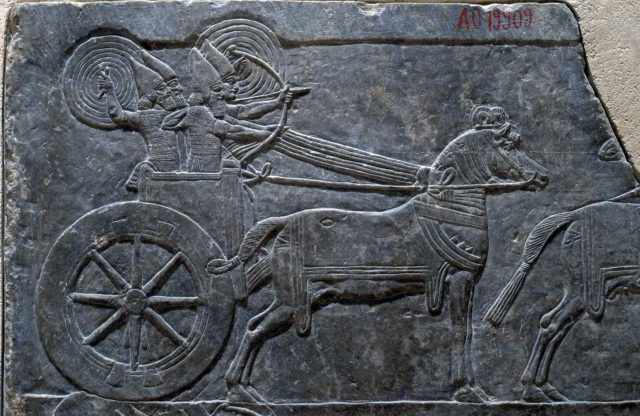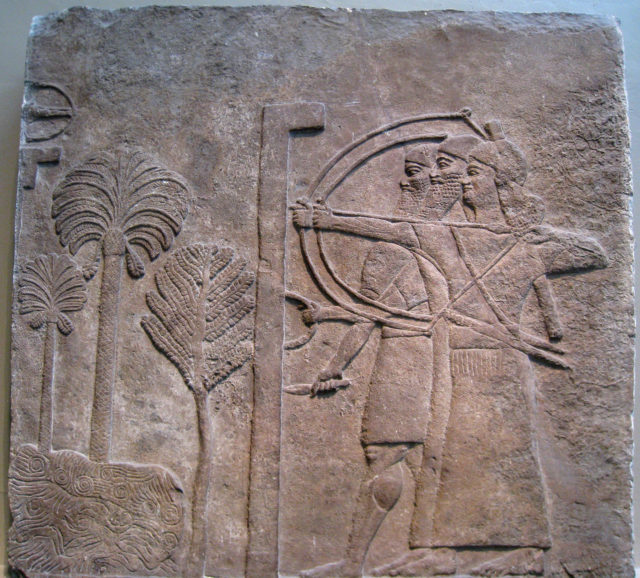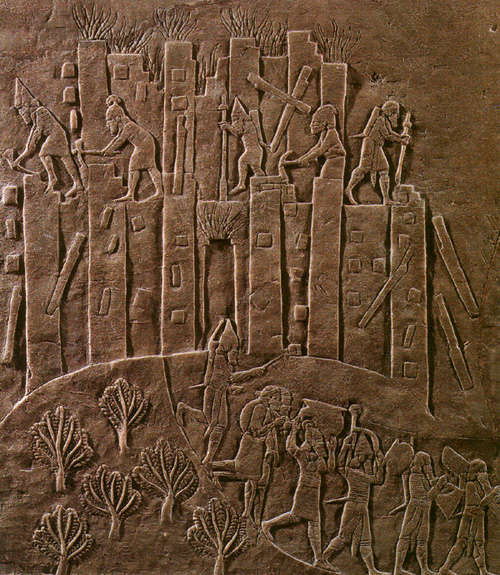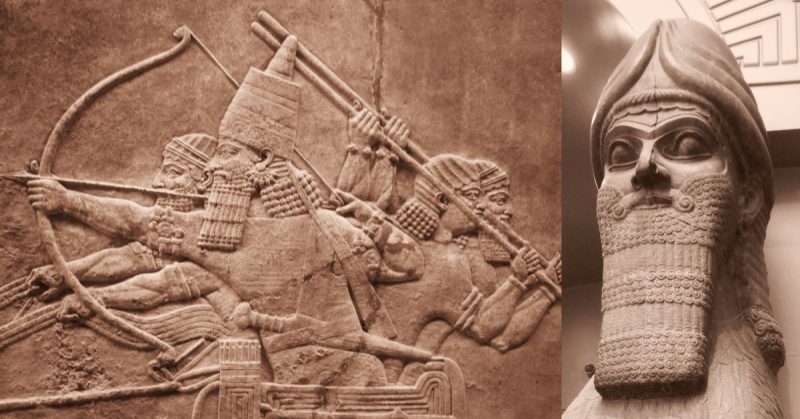The Assyrian Empire was one of the most powerful military forces in the Middle East. From the 14th to the 8th century BC, it grew from a defense of the Assyrian farming heartlands to a swathe of conquered territory running from the Mediterranean Sea to the Persian Gulf.
How did the Assyrians rise to such dominance?
Chariots
The striking strength of Assyrian armies came from their chariots.
The chariot was in use in the Assyrian region in the 13th century BC. It was developed by the Hurrian and Mittian people into a useful weapon of war. These early chariots were heavy vehicles drawn by four horses, more like transport wagons than the battle implements of later centuries. They provided a mobile platform from which attacks could be made and a quick way of moving around the battlefield. They were not very maneuverable.

As the centuries progressed, these wagons developed into agile two-wheeled chariots. They allowed Assyrian chariot teams to race around the battlefield launching powerful and sudden attacks. Initially, they were ridden by two men – one driving and the other fighting with either a lance or a bow. In later centuries, a shield-bearer or two was added, providing greater protection for those on board.
The Assyrians employed chariots in two ways. Sometimes they were used as shock troops at the center of an attack, breaking the strength of massed infantry. At other times they were used on the wings, harassing and surrounding the enemy.
Horses were so important to Assyrian warfare that raids were made especially to capture more. Lists of horse supplies were maintained.
Bowmen
The most effective tool of the Assyrian infantry was the bow. Many men were equipped with spears, but it was the bow that allowed the massed Assyrians to outfight their foes in open battle, in skirmishes in broken terrain, and in siege warfare.
The bows in Assyrian armies varied wildly. Some were composite weapons while others were simply made of wood. Arrows heads were usually metal, but some arrows were tipped with bone or flint. Tail feathers were obtained from eagles or vultures to make the flights.

Flaming arrows referred to as the “messenger of death,” were used when attacking wooden buildings and crops.
Formations of archers included shield bearers to protect the vulnerable bowmen. These shields were as tall as a man and sometimes curved over at the top to protect the archers from falling missiles.
An Organized Army
The troops were effectively deployed thanks to a very organized army.
The Assyrian Kings had a royal bodyguard, including a contingent of foreign troops, which provided a permanent fighting force and professional core for the military. The bulk of soldiers were raised by a mass levy from across the nation. Farmers, hill men, and nomads joined to provide a significantly large force.
There was a permanent branch of the civil service which kept a census of the Empire’s citizens. They could then be called up for tasks such as public building projects and wars.
Once raised, the army worked within a well-defined structure. At the head was the King. Next was a field marshal responsible for the details of running the military. There followed a clear chain of command down to the officers running units of ten men.
Large units were identified by standards showing divine symbols of gods such as Shamash (the sun) and Nergal (the god of destruction).
Supplies and Communications
Communication was essential to running large armies and bringing them to where they were needed.
Smoke signals and beacon fires were used to send pre-arranged signals over long distances, in particular warnings of an attack. Fires placed half a kilometer apart carried news of attacks and defeats.
Within the army, mounted messengers and runners on foot carried orders and reports.
The Assyrians were also organized with their supplies. In enemy territory, they often lived off the land, pillaging as they went. Within the Empire, stores were located at provincial centers to provide food for the soldiers. Travel rations kept them fed on the march.
Siege Warfare
The Middle East contained some of the world’s earliest fortified towns and the Assyrians inevitably ran up against these. Considering their formidable resources, they were extremely successful in their siege works.
On facing a fortified city, the Assyrians used starvation rather than assault. They built earth walls around a city and pillaged the surrounding land, ensuring that inside the citizens struggled for supplies. They would then hurl threats, propaganda, and orders to surrender at the people trapped within. No-one was allowed out until the city capitulated. The message was clear; there was only pain and starvation for those who held out.

When it came to attacking, the Assyrians used a formidable array of weapons, building on the existing technology of the region. Earth ramps and causeways allowed them better access to defenses. Heavy battering rams were hauled into place by beasts and men. Devices to soak these in water prevented the defenders from setting them alight.
When a river defended a town, the Assyrians built a siege tower and floated it downstream into position. From there, they gained considerable firepower against the people within the walls.
Systematic Expansion
Through a systematic approach to conquest, the Assyrians achieved a lasting expansion. The rulers of newly raided areas were forced to swear an oath binding them to obey the Assyrians or face further invasion. Satellite kingdoms were established. If the leaders got out of hand, the Assyrians moved in and conquered all their land.
Satellite rulers were obliged to provide troops and supplies. Supply depots and communication networks allowed the Assyrians to operate in these areas. By bringing each new area under tight control before moving on to the next, the Assyrians maintained their growth.
Through their careful organization, systematic strategy, strong tactics and technology in both battle and siege, they conquered a large swathe of the known world.
Sources:
General Sir John Hackett, ed. (1989), Warfare in the Ancient World.
William Weir (2006), 50 Weapons that Changed Warfare.
